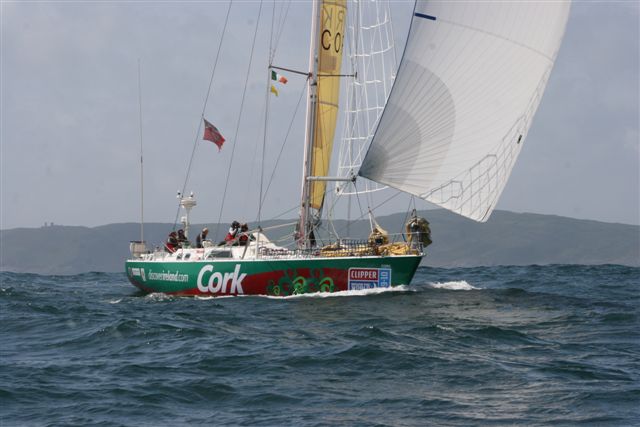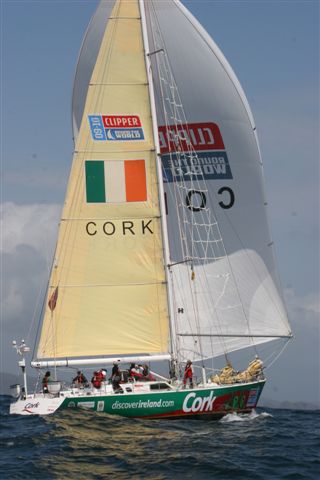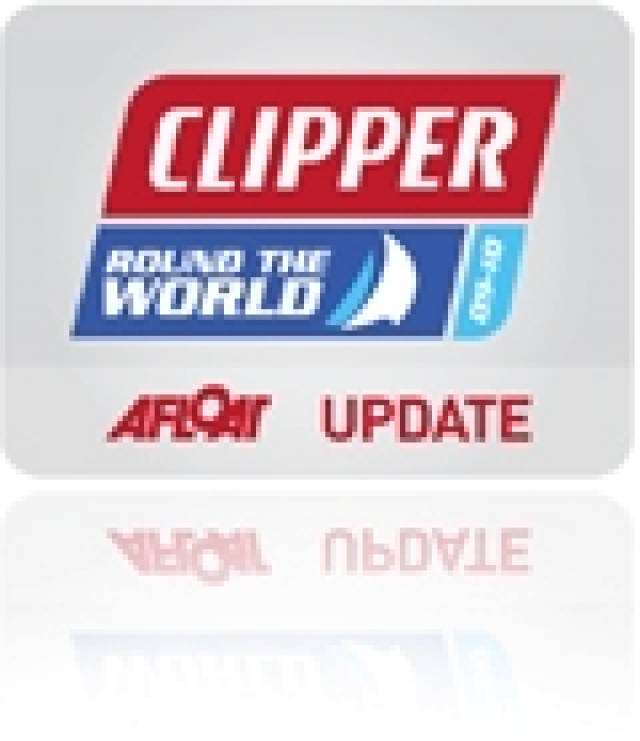Cork is edging closer to the Kinsale finish line tonight. Photos of Cork passing Cape Clear in West Cork below are courtesy of afloat.ie reader Richard O'Flynn. All being well it looks as though Cork will have the honour of leading the Clipper 09-10 round the world yacht race fleet into her home port.
"As we close in on the Fastnet the excitement levels rise," reports Cork's skipper Hannah Jenner. "After three difficult races aboard our new steel yacht we have found our groove in the North Atlantic. I have asked a lot of the crew and the boat has demanded even more. Every challenge has been met with enthusiasm, commitment and an absolute dedication to drive as hard as we can to make sure that upon our arrival in Kinsale, we can honestly say we couldn't have done any more.



All being well it looks as though Cork will have the honour of leading the Clipper 09-10 round the world yacht race, fleet into her home port. Over the past couple of days the Irish entry has been flying along and today still sees the team posting 12-hour runs in excess of 120 nautical miles.
"As we close in on the Fastnet the excitement levels rise," reports Cork's skipper Hannah Jenner. "After three difficult races aboard our new steel yacht we have found our groove in the North Atlantic. I have asked a lot of the crew and the boat has demanded even more. Every challenge has been met with enthusiasm, commitment and an absolute dedication to drive as hard as we can to make sure that upon our arrival in Kinsale, we can honestly say we couldn't have done any more.
"We still have a way to go and muscles are aching but the heavyweight kite is back up now that the sea state is less confused and we race on to the bitter end. Whether our efforts will be rewarded with a podium position is now in the hands of the wind gods so our focus is to hold off our closest rivals and be first across the line."
Cork is expected to arrive in Kinsale later this evening where they will be rewarded with a huge Irish welcome - something the team thoroughly deserves and which has been much anticipated by all on board.
All the team's thoughts are starting to turn to their arrival in Kinsale, none more so than Uniquely Singapore who, despite their best efforts, have re-emerged from Stealth Mode at the back of the fleet.
"As we slipped into our final Stealth Mode it was with just a hint of frustration as no matter what we have tried this race we have struggled to make the miles up on the other yachts," says skipper Jim Dobie. "With the low losing its dominance and heading away, the wind and sea has eased so now more than ever we are trying to get our best speeds out of her and pass the Fastnet Rock as soon as possible. The whole crew are looking forward to a Murphy's and spending some time in Ireland."
Jim is not the only skipper to realise that the final Atlantic race has not been theirs. Cape Breton Island skipper Jan Ridd admits the same thing in his report to the race office. It's something the team has found very frustrating as it threatens their second place on the overall leaderboard. Furthermore, Jan can't understand why after 24 hours of fast downwind racing his team has failed to make any gains on the rest of the fleet.
"It was with complete surprise that we discovered that some of the other boats had taken miles out of us," says Jan. "It does leave you bewildered - what have you got to do? According to the GRIB files we were in 10 knots more wind, we had positioned ourselves to get a good wind angle, we were averaging well over 10 knots and still we are losing miles to other boats.
"We are now looking for the wind and sea state to drop so we can hoist a spinnaker which should give us enough power to drop our mainsail and get on with some essential repairs. We have not been able to raise our mainsail above the second reef for a couple of days as we have a couple of major tears in the lower panels. Hopefully we will be able to start on it later today."
The Canadians are not alone with their mainsail issues and Qingdao's skipper has been left wondering why theirs has torn once more.
"We were making excellent speeds in winds gusting up to 50 knots and could probably stand taking the whole sail down to make the repair with only minimal loss of pace," explains skipper Chris Stanmore-Major. "But the sea state and general conditions on deck were not conducive for any normal sail repair - it being a Force 8 at the time. Alternatively, we could wait until the weather abated somewhat and crack on with the job then but that would be the exact moment when we needed more sail, not less. What do we do?
"As I speak the Qingdao sail repair team has already finished their work on our bucking, heaving, wave-washed decks in winds gusting 45 knots doing what they do best - fixing the Dragon's wings. You want tough?
I'll show you tough - it's not the hero on the helm or the plucky watch leader - no, tonight it was Kate, Kat, Becky and Barbara - with needles in their hands keeping our chances of a podium alive into Kinsale. The main is back up now after four hours under powered and we are out of Stealth Mode. Oh what's this? Hello Hull & Humber - remember us?"
It would seem that Hull & Humber are equally cursed and that all the team's could do with a bit of Irish luck rubbing off on them over the course of their next stopover.
The English entry's skipper, Justin Taylor, says, "Just prior to sitting down and writing this paragraph we decided to shake out our last reef to go to a full main. As I headed up into the breeze, something we have done dozens of times before, the starboard spinnaker pole holding out the Yankee headsail decided to fold back on itself...not good! We now have it down but its in two bits and useless....really not good."
These incidents are serving to remind all the teams that although the end is virtually in sight there is no room for complacency.
"Like the rest of the teams in the fleet we too have experienced equipment failures which have tested the resolve of the crew to the limit," says Team Finland's skipper Rob McInally. "None more so than when the preventer broke a couple of days ago in 40 knot gusts. The uncontrolled vang block made contact with one of our crew and the rest of the crew responded magnificently. Immediate first aid was administered on deck, the patient was stabilised and a full night of medical observations were carried out - both crew member and preventer are fully recovered.
"We are now entering the last 200 miles of the race we continue to push for that podium position that has eluded Team Finland for so long. The black stuff will indeed taste very sweet if we can maintain our position at the top end of the fleet."
Edinburgh Inspiring Capital's skipper has been reminded of Sir Robin Knox-Johnston's words of warning 'your not home yet.' A reminder that although the Atlantic may not have the same reputation as the Pacific it can certainly deliver just as heavy conditions as its larger sibling.
The Scottish entry's skipper, Matt Pike, says, "The last ocean. Just a dash across the North Atlantic and it would be easy to get complacent.
We headed north up into the low to find the wind and to start with it was a fantastic - 20-25 knots and just enough swell to get the purple beastie to surf. The wind steadily built and so did the sea state until we reached the point of selective helming - normally everybody takes their turn but there comes a point where a bit more strength is required to keep the boat on course.
"Freddy took the wheel and had hardly got both hands on before the bow buried itself under tons of water, slowing the boat down and allowing the next wave to pick up the stern. He kept control and we lurched forward accelerating rapidly as the next surf passed under us, the speed kept climbing as the bow lifted and was in mid air hanging over a trough some forty feet below. It seemed like minutes but was probably only 15 to 20 seconds and it felt like the big purple beastie was air born.
There was even a murmur heard from those witnesses on deck of buy that man a beer!
"So the Atlantic may be considered the Pacific's little sister, but has proved if proof were needed that we are in fact 'not home yet.' As for the beer, please form an orderly queue behind the skipper."
California's skipper Pete Rollason is looking forward to what promises to be an amazingly close finish but believes that the tides along the Irish coast could make or break any of the teams in the final stages.
"It looks like we may arrive at the Fastnet Rock in time to catch a favourable tide along the coast and into Kinsale," explains Pete. "An hour or two earlier or later and it could be a totally different ball game with one boat getting the current and one missing it. The weather has started to ease as predicted and back to the south west which should help everyone in their course towards the rock.
"As we know only too well it is never over until you cross the line and on the run into Cape Breton we managed to claw back six miles in the last 20 miles of the race to overtake the boat in front - so here's hoping we can have a repeat performance. We can almost taste the stout and look forward to our arrival into Kinsale."
California's skipper is not wrong about the close finish and having emerged from Stealth Mode and back on form, Jamaica Lightning Bolt is breathing down the necks of Team Finland - although the Finnish entry is doing well to keep them at bay.
"Given the distance to finish and the wind we have there wasn't really any advantage in doing anything other than sail the best course possible towards the Fastnet Rock, so that is what we have done," explains skipper Pete Stirling. "We have some 170 miles to go to the Fastnet Rock and a further 45 miles after that to the finish line. There is still everything to play for with the wind forecast to get lighter which will make the final stages of this race more tactical."
Zoe Williamson
Positions at 1200 UTC, Sunday 27 June
Boat DTF* DTL*
1 Cork 57nm
2 Team Finland 151nm 94nm
3 Jamaica Lightning Bolt 156nm 99nm
4 Qingdao 190nm 133nm
5 Hull & Humber 195nm 138nm
6 Spirit of Australia 206nm 150nm
7 Edinburgh Inspiring Capital 219nm 163nm
8 Cape Breton Island 226nm 170nm
9 Uniquely Singapore 244nm 188nm
10 California 274nm 217nm
*DTF = Distance to Finish, *DTL = Distance to Leader)































































